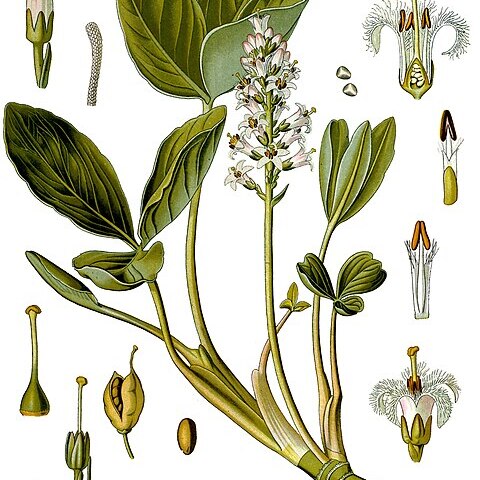Aquatic or marsh herbs with a tufted rootstock or creeping rhizome. Leaves floating or submerged, alternate, entire or trifoliate; petiole sheathing at the base. Flowers bisexual, rarely unisexual, solitary, paired, racemose or fasciculate or in many-flowered cymes, panicles, or involucrate heads. Calyx 5(-8)-lobed or-partite. Corolla sympetalous, 5(-8)-lobed; lobes valvate or induplicate-valvate, margins or inside sometimes fimbriate or crested. Stamens 5(-8), inserted towards the base of the tube or between the corolla-lobes; anthers 2-thecous, sagittate and versatile. Nectaries usually present, hypogynous. Ovary superior to semi-inferior, 1-locular with 2(-5) parietal placentas; style 1, 2(-5)-fid at the apex. Fruit a capsule, usually 4-or 2-valved, rarely fleshy or pulpy and indehiscent. Seeds few-numerous, winged or not, with copious endosperm and small embryo
Herbs perennial [or annual], aquatic or nearly so. Leaves alternate, rarely opposite, simple or 3foliolate; stipules absent. Flowers (4 or) 5merous. Calyx lobes free or united. Corolla lobes united, valvate in bud. Stamens 5, free, alternate with petals. Ovary 1celled. Pollen grains bilaterally compressed, ± triquetrous, with 3 apertures. Ovary superior, 1celled. Fruit a dehiscent or indehiscent capsule. Seeds few to many, sometimes winged; endosperm abundant.
Leaves floating or submersed, alternate or in a rosette, simple or compound, entire or crenulate; stipules small, rounded, scarious, or inconspicuous
Flowers in panicles, racemes, fascicles or solitary; actinomorphic, generally 5-merous, hermaphrodite or unisexual
Stamens inserted towards the base of the tube or between the lobes; anthers 2-celled, sagittate or versatile
Stamens as many as corolla lobes and alternate with them; anthers dithecous, opening by longitudinal slits
Corolla gamopetalus, often with a short tube, lobes membranous, often fimbricate or pilose
Corolla-lobes valvate or induplicate-valvate, margins on inside sometimes fimbriate
Leaves alternate, entire or 3-foliolate, sometimes orbicular and peltate
Aquatic herbs, with tufted rootstock or horizontal creeping rhizomes
Fruit a 4 or 2-valved capsule, or fleshy and indehiscent
Ovary superior, unilocular with 2(5) parietal placentas
Ovary superior 1-celled, with 2 parietal placentas
Seeds with copious endosperm and small embryo
Sepals free or almost so, imbricate in bud
Seeds often numerous, with endosperm
Flowers hermaphrodite, actinomorphic
Fruit a capsule, dehiscent or not
Style 1, bifid at the apex
Aquatic or marsh, herbs
Ovules few to numerous

